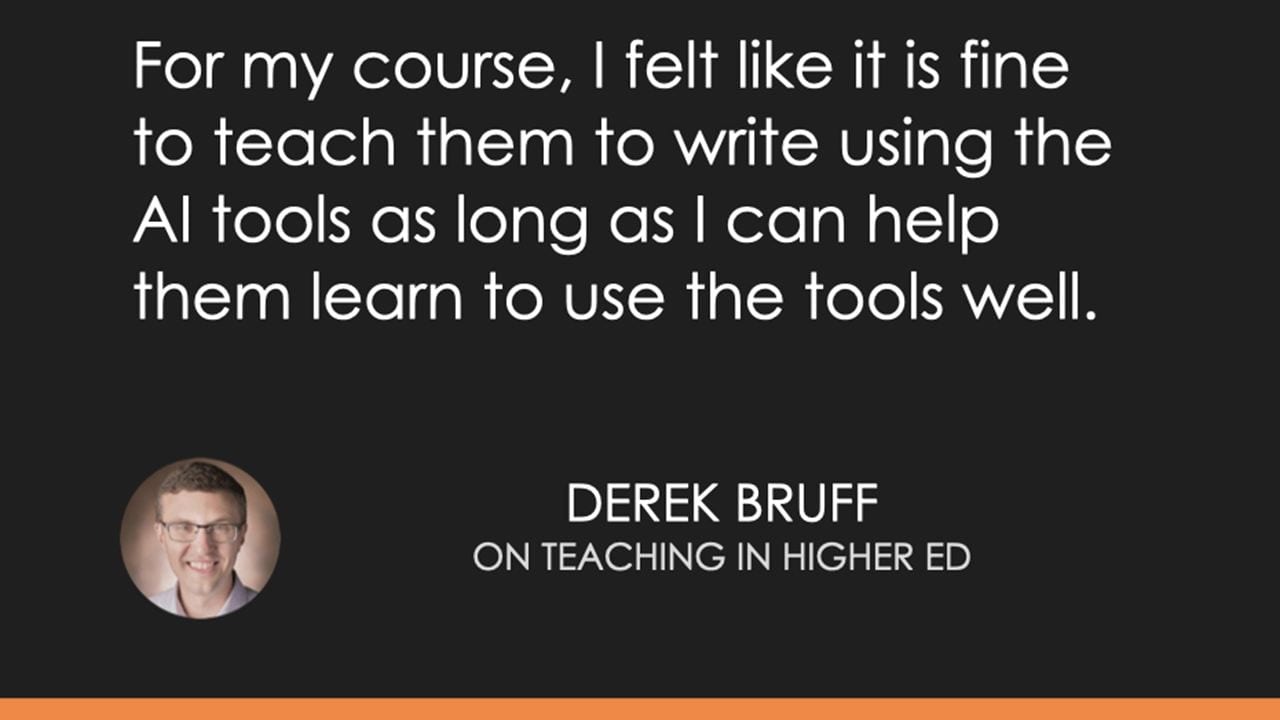
“For my course, I felt like it is fine to teach them to write using the AI tools as long as I can help them learn to use the tools well.“
-Derek Bruff
Hello, faculty!
We recognize how overwhelming incorporating Artificial Intelligence (AI) into college courses feels. However, remember to be open to AI in some instances as it can offer several advantages. Doing so will ensure that students are prepared for the modern workforce by exposing them to AI’s pervasive influence in various industries. AI coursework can be interdisciplinary; bridging gaps between computer science, mathematics, ethics, business, and other fields.
This integration can personalize learning, improve the achievement of student outcomes, and promote the development of analyzing and thinking critically. It also provides opportunities for students to work on real-world applications, grapple with ethical considerations, and engage in innovative research. Moreover, it enhances global competitiveness, opens doors to better career prospects, and promotes inclusivity through AI-driven accessibility tools.
We’ve curated several resources on how to weave AI into your teaching, how AI can enhance assessments, and insight into the student perspective – Enjoy!
-The ID Team
CITS | Instructional Development

Who:
This week we have curated resources that introduce several ways AI can be incorporated into your course, through assignments, and in your planning. Start by defining clear learning outcomes and selecting relevant AI tools and resources for well-aligned assessments. Engage students in hands-on AI projects, encourage collaboration, and offer scaffolded steps to each formative activity. As you design, think about promoting interdisciplinary integration, emphasizing ethics and critical thinking, and consider inviting guest experts for real-world insights. Utilize diverse assessments, gather feedback, and stay updated with the evolving field of AI. Instructors can also use AI-driven tools to recommend personalized learning paths, assist in grading, and provide rapid feedback. Virtual assistants and chatbots enhance support, and adaptive learning platforms customize content. It’s crucial to integrate AI thoughtfully, complementing rather than replacing human teaching, with regular assessment and refinement.
How:
In this edition learn how to:
- Embrace AI to devise creative and engaging assessments.
- Future-proof your course(s).
You:
Our goal for you is to:
- Gain insight into the impact AI will have on your students, in your course and beyond.
- Brainstorm and incorporate varied assessments.

Students are using artificial intelligence and other tools to assist them in their academic careers. Three students share their viewpoints on the tools they use and how AI helps them in their schoolwork and prepares them for the professional world.
 |
Embracing Constructive Dialogue and Oral Assessments in the Age of AI
Since AI is here to stay, instructors should consider using new approaches to assessing student knowledge, write Graham Clay and Cambriae W. Lee. They offer ideas for preparing dialogue-based activities and assessments, including how they can be enhanced with AI. |
 |
4 Steps to Help You Plan for ChatGPT in Your Classroom
–The Chronicle of Higher Education Why you should understand how to teach with AI tools — even if you have no plans to actually use them. |
- ⚠️Attention Blackboard Collaborate Users: Clean up coming!
- Review myCourses Policies and Procedures.
- Are you using SafeAssign in myCourses to check for plagiarism?
- Check out our resources on Instructional Continuity!
- Make your content accessible with Ally.
- 10/12 – Introduction to Excel
- 10/13 – Zoom Tips
- 10/17 – Creating Forms with Adobe Acrobat
- 10/18 – Online Teaching and Learning Strategies
- 10/19 – Excel Charts
- 10/24 – Introduction to InDesign, Part 1
- 10/25 – Getting Started in Qualtrics
- 10/26 – Excel Pivot Tables
- 10/31 – Introduction to InDesign, Part 2
- ⭐️Save the Date – Annual New Approaches to Teaching and Learning Conference
- Check out our other self-paced offerings!
Instructional Development works with faculty to…
- Explore, design, and experiment with different teaching and learning modes.
- Research and integrate technologies that can enhance teaching and learning.
- Design and develop online courses and programs.
- Write learning outcomes, design assessments, craft activities, and develop content.
- Utilize best practices for using instructional technologies.
Feel free to contact us online to book an appointment!







